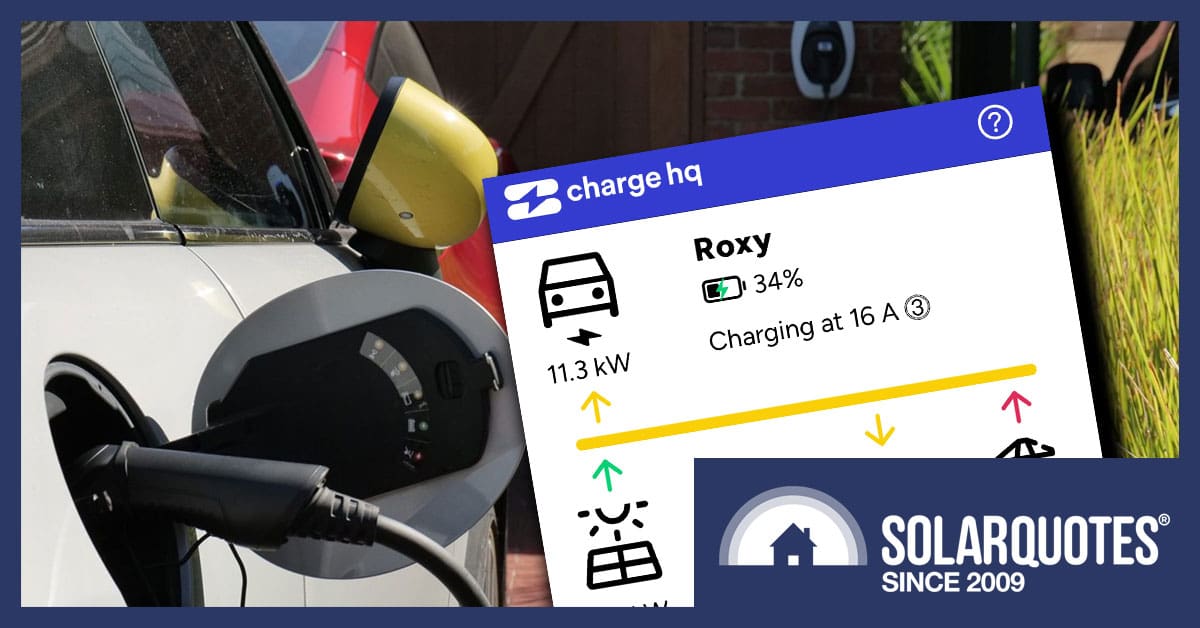
Charging at 16A on 3-phase = 11 kW charging rate.
Solar power systems have been saving us money for years, but what about saving some for later? With large solar arrays on houses becoming the norm, finding places to store all the goodness is becoming more important. Faster EV charging is an excellent place to start.While remote area power has been using batteries since forever, lead-acid chemistry has been the mainstay. A lumbering grey battleship, lead kept the lights on for farmers and powered phone exchanges everywhere, but technological advances mean smaller, lighter lithium-ion batteries are now delivering much higher performance in terms of useable capacity and charge rates.
This performance makes electric vehicles practical passenger cars over hundreds of kilometres now, where lead acid was limited to delivering milk to houses or golfers to the 19th hole, after which you had all night to charge up.
State of Charge
Although we could always charge batteries quickly, getting from half flat to fully charged traditionally takes hours and hours.
No matter how much sun, wind or diesel you had to throw at them, caring for lead-acid batteries meant slow charging.
It’s ironic that people are paranoid about lithium battery fires when flooded lead acid produces hydrogen, known to explode in a fashion SpaceX would call a RUD (Rapid Unplanned Disassembly).
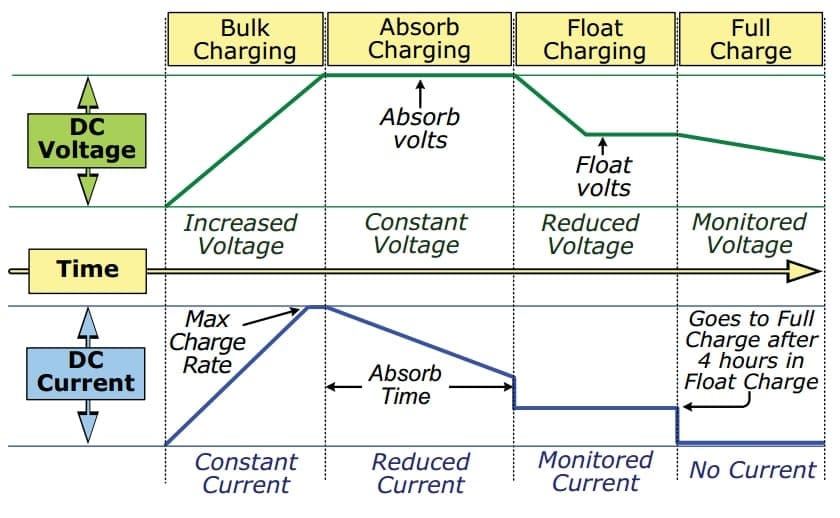
It’s only the first stage that lead acid will accept “bulk” energy quickly. credit generationsolar.com
Current Technology Has Changed Everything
Modern lithium batteries aren’t immune to physics. Current creates heat which a Battery Management System must tightly control. Where lithium batteries differ profoundly is the rates of charge.
From nine-tenths flat to nine-tenths charged, you can belt lithium with 100% rated current. Throttling back to float charging only occurs when the battery is almost full.
Not only can you use more of the sticker rating on a lithium battery, discharging to great depth without damaging it, but you can also use it faster. To stretch the marine analogy, it’s like a submarine crossed with a speed boat.
How Does This Speed Help Your Budget?
While domestic storage batteries have been the buzz in solar for a few years now, at roughly $1,000 per kWh installed, they’re an expensive gadget. Meeting the consumption of an average Australian house with storage means buying 20kWh. It’s a big investment to save 35 cents per kWh.
However, the largest battery you’ll buy will be three, four or more times the size of a Powerwall; it’s the battery in your car. If you can charge it with solar instead of buying petrol, you’ll save lots more money.
This is why we’re seeing the movement to Rewire Australia taking off. Making Everything Electric simply makes economic sense. Adding energy security, economic sovereignty and pollution abatement to the calculated return on investment makes this energy transition nothing short of a revolution. It’s not hyperbole I use lightly.
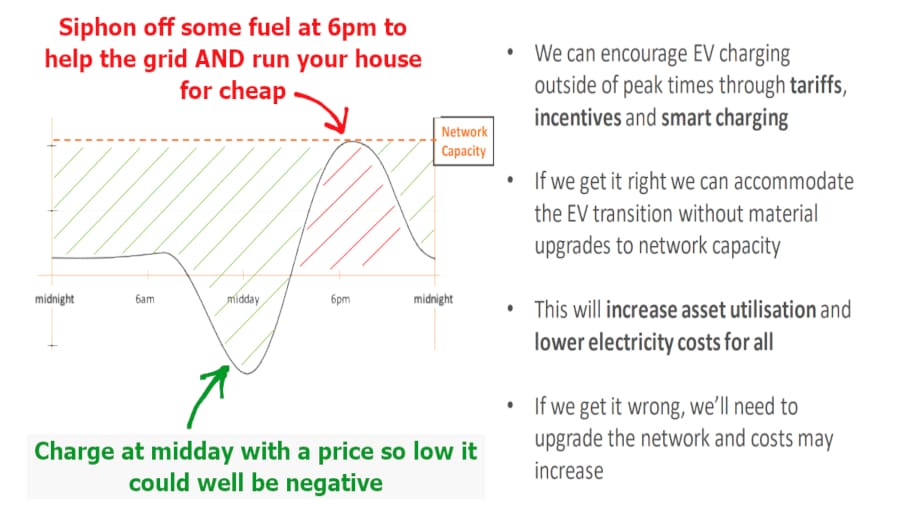
An ideal daytime cycle showing money saved on cheap charging and grid capacity bolstered by EV batteries
Large Solar Loves EV Batteries
Combining large batteries with large solar power systems allows you to store large amounts of energy. There may be a missing link, though; if you’re a tight-arse like me and your EV chargers can only pass 2kW through to the car, your charging speed will be so low most of your available solar energy will be exported for 5 cents, or worse still curtailed to zero by an export limit.
How Does This Speed Affect EV Charging?
Let’s assume 15 kWh of electricity will get you 100 km of range in your EV.
So, how long does it take to charge 15 kWh? The world’s not perfect, so with losses, a rule of thumb would read like this:
-
Level 1 Slow Charging:
- Via any 10 amp general-purpose power point is around 2 kW; at that rate, you’ll gain:
- 13 km added every hour
- 100 km will take 7½ charge hours
-
Level 2 Charging: Governed by your car’s onboard charger
- Available to all but the most modest of EVs
- default AC charging anywhere, anytime you find a single phase 32 amp or 7 kW connection
- 40 km added every hour, realistically
- 100 km will take 2 ½ charge hours
-
Level 2 Charging with 3 phase: For better-appointed cars
- Larger EVs can handle 11 or even 22kW charging
- This is akin to the “high flow” diesel pumps at the petrol station
- 120km added every hour is plausible
- 100km will take 1 ⅓ hours
All these charge rates use simple assumptions. Battery temperature may extend the time as the car determines what it’ll accept.
-
Level 3 Charging with a Highway DC Fast Charger:
- DC charging isn’t a thing for domestic premises yet.
- Generally speaking, DC charging from zero to 80% takes just as long as getting from 80% up to fully charged.
- If someone else is waiting at a public charger, filling your tank over 80% is considered bad form.
- 250 km could take as little as 20 minutes, depending on the car and station, so driving another 2 hours for the next top-up takes less time than fully charging at every station.
How Does This Help With Harvesting Home Solar?
Imagine you have a large water tank, yet pouring rain is overflowing the gutters and running down the street because you only have one skinny downpipe.
If you’ve invested in a big solar system, I’d recommend you futureproof it with a big power supply to the garage, even if you have yet to get an EV. Once you have an EV with a 50kWh+ battery AND the infrastructure on the wall to connect it to your roof, funnelling sunshine into your car efficiently is easy.

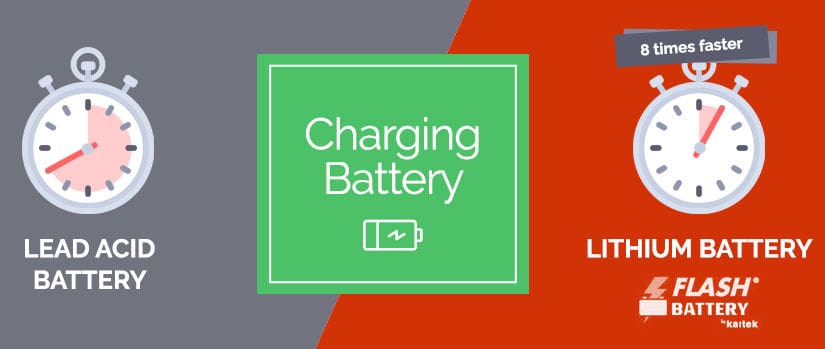
 RSS - Posts
RSS - Posts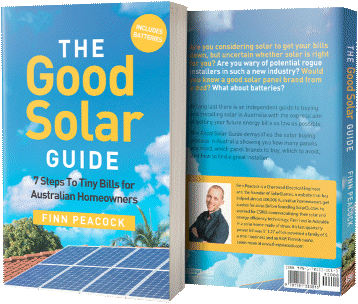



Supersizing home solar for 11kW three phase charger is awesome. Another benefit is that you can still do solar-only charging even in an overcast winter day! I really struggled to do winter charging with our old house at 9kW, but don’t have issues with 21kW over 3 phase now
I have done almost precisely this. Nearly 20kW in panels connected to a 15kW 3ph charger. I can charge basically for free from about 10AM to 3PM as SAPN insists on throttling the solar down severely otherwise, 11kW means it is always a full battery regardless of how empty it was. Only problem would be if I was to not WFH, this would be harder to achieve except on weekends (and do you really want to be home all of the day on weekends!).
On the plus side, even when I am out, when I get home I can get enough charge before sunset to fully top up, sometimes throttling the amps to avoid drawing grid power.
This is how I look at it for my home EV Charging.
I drive about 40km per day (mostly to work/home and some errands).
That requires about 5.88kWh (at 6.8km/kWh, what my EV’s economy or 14kWh/100km) per day. I’ll round that up to 6kWh.
Now, if I exported this to the grid for 15c/kWh which would be forgone solar FiT of $0.90 (6kWh x 15c/kWh) if I used it to charge the EV. Even worse, if solar FiT is lower than 15c/kWh.
The petrol equivalent for cost per km with ULP91 at $2.38/litre, this comes out to $0.18872/km (on my old ICEV @ 8.2l/100km). So, the 40km drive would cost me $7.54 (40km x $0.18872).
This effectively makes my solar stored energy worth $7.54, when the solar energy is put into the EV instead of the grid. This means a net gain $6.64 per day.
Over a year, that solar energy being used to charge an EV is worth about $2755 in petrol costs alone to forgo $328 in solar FiT earned. It becomes very obvious how much solar energy is worth when used for EV Charging.
The point? Solar self-consumption is increased dramatically in value when used for EV charging when compared to using self-consumed solar energy for household appliances.
What would be worthwhile as a separate discussion is to delve into ways to get beyond a 5kW inverter and 6.5kW of panels. While going 3-phase is one way, is it possible to now have an export limitation on your inverter to keep the export below 5kW and still have more than 6.5kW of panels
Yes, this is possible. I have 13kW of panels, 10kW inverter on a single phase power supply.
On a sunny day with no load from the house, my inverter will automatically limit the export to 5kW. But if I have my EV plugged in I can send say 7kW to the EV and export the excess 3kW.
Agreed. Living near mountains means higher level of clouds. . I have often wondered why I can’t put in extra solar of my 6.6 system to 7.5-9kw to compensate.
Great article – thanks.
I have 13.3 kw solar. 10kwh battery and an EV, so well set-up. For those of us who’re retired, time is not really an issue, as we are often home during the daytime and can divert solar to the EV, keeping it topped up and using battery to keep things going in the evening. The ultimate package though is to be able to supplement the grid from the EV when grid-demand is high, because – guess what – that EV is going to be topped up again the next day!
Regarding DC fast charging, I still find that many drivers want to squeeze the last bit of juice into their battery to 100%. Not sure how we educate everyone.
Simple. Battery 0-80% change to 0-100% for labelling sake
Last 20% call it boost, or Reserve range.
Or simply do an iPhone, which is show 100% when really it’s 90% so when battery degrades, it’ll still have “100%”
Anthony,
I feel what we need is 3 phase Hybrid inverters that will sync with a single phase supply. How I see this working is the house loads would basically run off one phase, the same as the Single phase supply. There would be a household battery charged by the Hybrid inverter, & if the inverter has spare PV capacity, & a 3 phase load is detected (such as a connected EV), the inverter would offer power on the 3 phases.
In the future with V2G, perhaps the vehicle could power 3 phase loads too for when the Sun is not shining. There is also the possibility of supplying the grid power to the 3 phase inverter so the vehicle could be charged at more than 7Kw (ie draw 40A from the grid & supply to the vehicle 3 phase at 11Kw for faster charge.
All we need now is a manufacturer to supply such an inverter! (I feel much of this could be done now with Selectronics SP Pro x3 I feel, but at a cost)
Coincidentally I saw this in my inbox on a lovely cool sunny day having just finished topping up the EV at 11kW, mostly from solar at 9kW with the difference coming from the grid at 2c/kWh (courtesy of wholesale pricing via Amber). I can’t yet discharge the EV battery back into the grid, but the house battery is still charging from solar, ready to sell back to the grid this evening at what’s currently forecast to be 16-20c/kWh. Solar + battery + 3-phase + EV + wholesale pricing provides lots of flexibility.
Interesting. I have just been told that on single phase, my maximum feed in is 5KW per hour whereas on three phase it is 5 KW per hour per phase. Is this correct? If so, I am better off spending the money on upgrading to 3 phase than on a battery. Am I correct?
Hi Gerhard,
3 phase is a great move in any case. More solar makes more sense than a battery in my opinion, but exports aren’t the deal breaker these days, what you’re aiming to do is self consume.
“Generally speaking, EV charging at home from zero to 80% takes just as long as getting from 80% up to fully charged.”
I think you meant “At a DC Fast Charger”
well spotted – fixed
Yesterday I put 27 kWh of photon energy into the MG4, coincidentally from a 27 kW array, but limited to 6.5 kW charge rate that the Victron EVSE provides on single phase. (32A) Compared to the cost of the array, two 6 kW PV inverters, two 8 kVA battery inverters, and 46 kWh of batteries, the level 2 charger was incidental. On Graham’s figures, it’ll pay for itself in six months anyway. It would take a good bit longer for the rest of the system to do the same, except bringing in grid power would have been several times the cost.
When you can save money while saving the planet, then the planet has a chance.(Legacy car manufacturers do not.)
The installer was here till after dark, figuring out how to enable “Automatic” mode on the Victron EVSE. Several reconfigs later, it can stay in the mode now, so I’ll soon be able to try using only surplus solar for EV charging. Manual control has been a bit tiresome, though still much better than fouling the atmosphere with a fossil car.
There’s an optional V2L cable for the MG4, which allows a limited 2.5 kW (or so) to be taken from the EV battery. I’ve yet to pull the house battery below 95% overnight, and even in medium overcast that’s recharged by 9 a.m., and I can often pull the 2.4 kW for the HWS in that soup too. That means the batteries have done 3 cycles in two months. Cycle life isn’t going to be a big problem by the look of it. (Might have overdimensioned the battery a bit. But winter is coming!)
There are now EV farm vehicles, including small to medium front end loaders – with posthole auger and trenching bucket options. Only the bigger ones seem to have LiFePO₄ batteries, and they don’t seem to provide level 2 charging. Slow charging of a working vehicle is a painful bottleneck. It’s not just utes that need to get here a bit faster.
Great article Anthony.
My question is – Why are home batteries so expensive? You quote about $1,000 per kW.
I have a BYD Atto 3 with a 60 kWh battery, yet it cost me $50,000 (or $833 per kW) and I can drive it around, go shopping, and go on trips.
I can even use it to power my essential home appliances (fridge, freezer, lights) when there is a power outage.
How come a Tesla powerwall costs so much more per kW than a BYD Atto 3?
By my recollection, the Tesla Powerwall has an integral inverter/charger, as it is AC coupled. That’s a lot more than a battery. But the general point stands; solar battery prices have generally not adequately followed the falling market price. Not just EV batteries are coming down.
I’ve left the rest of this post as written but added some emphasis because it should be prefaced with a post about electrical work.
Even though you don’t need a licence, ELV (extra low voltage) isn’t something to be trifled with. Batteries that can deliver hundreds of amps in service are capable of melting a spanner instantaneously. If you’re holding that tool it will cause severe injury.
Even a 12v car battery can explode in your face. I know because it’s happened to me personally.
If you don’t know what a HRC fuse is or how it differs from a circuit breaker, if you can’t calculate a CAL rating for arc flash & the appropriate safety equipment, then electrical work is best left to professionals.
https://www.solarquotes.com.au/blog/diy-wiring-danger-australia/
I have here a hardcopy advert for a 12.8v 150 AH LiFePO₄ battery for $650. That’s 650/(12.8*150) = $338.54 per kWh. These units have their own bluetooth controlled BMS, it appears. And remarkably, these units can be series connected up to 4 for 48v, it says. I haven’t seen that allowed before. That would make a 7.68 kWh 48v bank for $2600, I figure. They can also be parallelled up to 4, apparently. There must be more out on the internet.
While they are not the units I used, it is possible that they might be a more consumer-friendly alternative to the individual prismatic cells and all the hassles and risks of DIY busbar assembly and BMS configuration & management. (Not a recommendation, just an observation; it might work out fine in qualified hands. There is a _lot_ of dangerous energy in such a bank.)
I’ve used EVE brand cells. The other most reputable Chinese manufacturers are CATL and Gotion.
Installation would still need an electrician. (And inspection/sign-off.) The ELV part may be done by a suitably qualified and experienced person, but the very high currents for useful power at 48v increase the risk of fire as the square of the current, and suitable HRC fusing or adequately rated _DC_ breakers in both leads are _fundamentally_ vital.
Anthony: Please chop above as needed. We don’t want to encourage inexperienced folk to take risks. But reporting on the crumbling edge of battery prices may help some people stretch their budget for e.g. camping or ride-on mower conversions. (There’s one of them on my to-do list.)
Projected cycle life is not stated in the advert. That’s a risk bargain hunters can’t easily avoid.
I will soon be moving to a house with 6.6 kW Solar edge panels. I have a Kona EV (my second) which I currently charge from DeltaAC MiniPlus Charger, installed when I bought the first Kona EV. This charger will stay when I sell current property.
So I will certainly be buying a new charger and probably a battery, though battery economics are a bit doubtful as I live alone and not lavishly. I would prefer to use car as a better house battery. It’s paid for. When will it be permissable to use a EV battery for V2H? I have heard could be October for WA, up to Western Power I suppose. Will my Kona EV be able to do this (presumably with required electrical work on car and house?). Should I have an electrician do or not do anything now to prepare for this V2H in the future?
PS Thanks for great blog, information and recommendations which I have followed happily for three solar panel installations